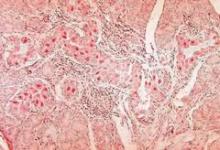BERNALILLO, N.M. – Results were mixed in an Italian trial of hyperimmune globulin to block intrauterine transmission of cytomegalovirus, an investigation that was largely an attempt to replicate a well-known but uncontrolled 2005 study in which the agent appeared to do just that.
Thirty percent of women (18/61) with primary cytomegalovirus (CMV) infection given intravenous anti-CMV hyperimmune globulin (Cytotect, Biotest) until gestational week 36 – or CMV-positive amniocentesis – passed the virus on to their fetuses or newborns. The transmission rate was 44% (27/62) in the trial’s saline-placebo arm, but the difference was not statistically significant (95% P = .13).
Hyperimmune globulin–treated women also had a higher incidence of serious obstetric adverse events, including preeclampsia and fetal growth restriction (P =.06). Preterm delivery was the most frequent problem; there was one preterm delivery of an infected infant in the placebo group, but there were seven in the hyperimmune globulin (HIG) group – six noninfected infants and one infected infant.
"In some cases, prematurity was rather severe," but the medical records of the women haven’t been reviewed yet to see if they had risk factors for early delivery, said lead investigator Dr. Maria Revello of the IRCCS Policlinico San Matteo in Pavia, Italy.
Overall, "the safety and efficacy of HIG for the prevention of [CMV] transmission remains to be established in phase III studies. The jury is still out," she said at the annual meeting of the Infectious Diseases Society for Obstetrics and Gynecology. One such trial is underway in the United States, with an enrollment goal of 800 women.
There were no significant differences in virus antibody kinetics, weeks of gestation at enrollment, blood viral loads, and other factors among women who transmitted the virus in either trial arm. Likewise, there were no significant differences in amniotic viral loads, ultrasound findings, clinical birth outcomes, and other factors between infected fetuses and newborns in the two arms.
The results seem to be at odds with the 2005 project and its finding that HIG decreased intrauterine transmission from 40% to 16% (N. Engl. J. Med. 2005;353:1350-62).
That study "raised a lot of interest and a lot of expectations," but because it wasn’t a randomized controlled trial, the authors called for one in their conclusions. "That’s what we did," Dr. Revello said.
Her team used the same drug at the same dosage, 100 U/kg monthly. About 60 women were in each arm because that was the number needed to demonstrate a significant reduction in transmission from 40% to 16%. Enrollment was limited to those who picked up the infection between 5 and 26 weeks of gestation, because that’s when the rate of transmission is thought to be 40%.
The "results are actually quite encouraging because they do suggest there’s efficacy," said Dr. Stuart Adler, an author on the earlier paper, after hearing Dr. Revello’s presentation.
"Your study was slightly underpowered, but it was not significantly different in terms of efficacy rate. If you do a logistic regression of the two studies, it looks like the efficacy would be about 50%, probably because a lot of those babies were infected prior to receiving Cytotect," said Dr. Adler, a pediatric infectious disease specialist at Virginia Commonwealth University in Richmond.
Even so, until there is a proven treatment to block intrauterine CMV transmission, the best way to prevent it is to identify women who are not infected and teach them how to avoid the virus while pregnant, Dr. Revello said.
The virus is usually picked up during pregnancy through sexual contact or contact with the urine or saliva of young infected children.
Dr. Revello and Dr. Adler reported no relevant financial disclosures. The study was funded by the Italian government.


